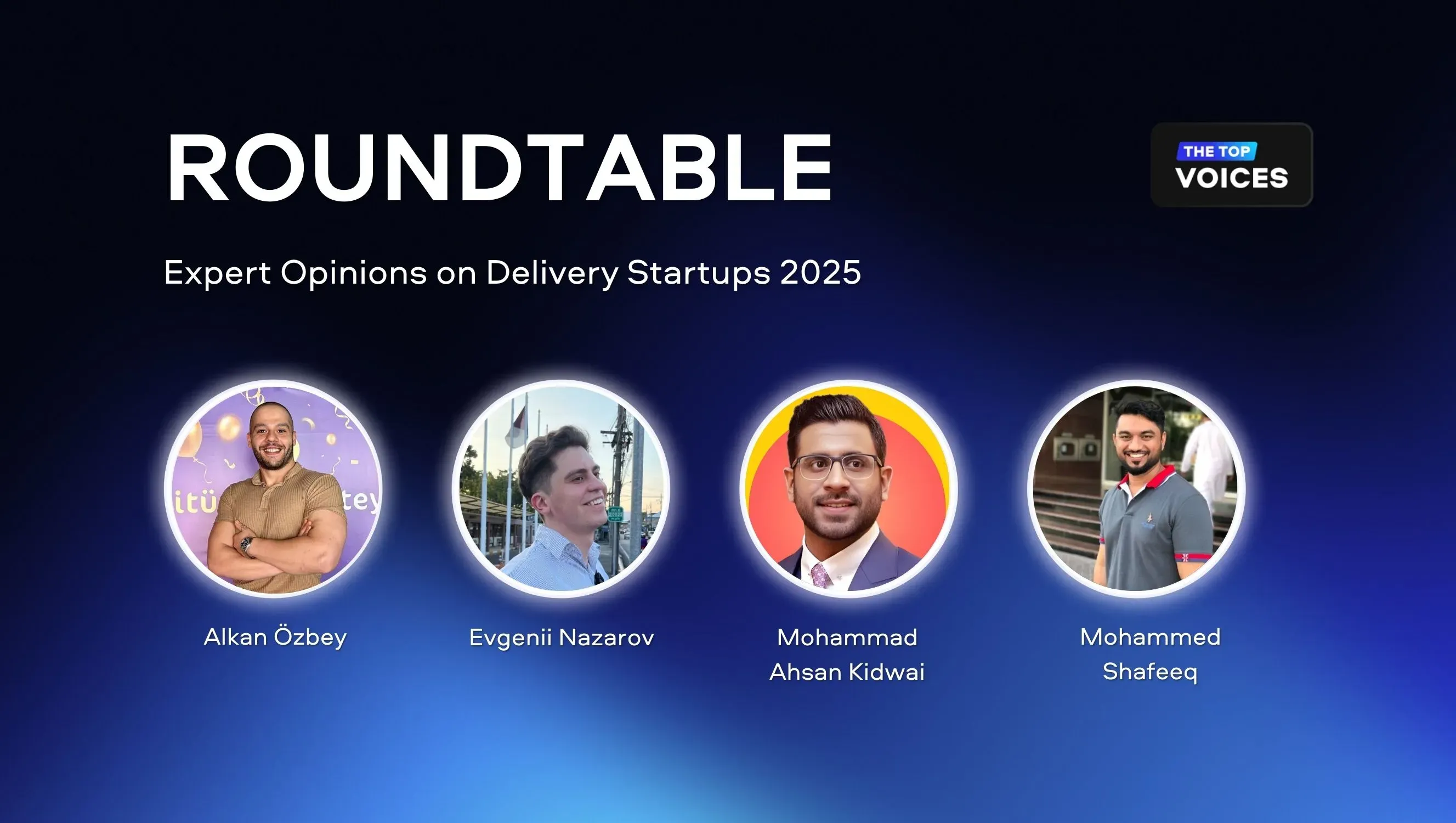Expert opinions on delivery startups in 2025 will uncover the trends shaping how founders approach growth and innovation in this fast-evolving sector. To dive deeper into the challenges and opportunities, we are hosting a roundtable discussion with leading industry experts. In this session, professionals will share their insights on the main barriers currently preventing innovative delivery services from scaling, the key technologies transforming the market over the next 3–5 years, and how customer expectations around speed, sustainability, and personalization are reshaping the industry.
Our experts:
- Alkan Özbey, Co-Founder
- Evgenii Nazarov, Technical Lead Machine Learning
- Mohammad Ahsan Kidwai, Co-Founder & CCO
- Mohammed Shafeeq, Business Development Manager
Alkan Özbey, Co-Founder

What are the main barriers currently preventing innovative delivery services from scaling?
When data is not properly leveraged for demand forecasting , route optimization and vendor performance analysis , cost increase significantly.This directly limits scalability, as operational efficiency is a prerequisite for sustainable growth. Also customer expectations evolve quickly. Customers expect both faster and cheaper delivery. Companies that cannot anticipate and personalize offerings based on these shifting expectations struggle to scale effectively.Additionally, from a data integration and strategic decision-making perspective, failure to integrate data from different systems makes it difficult for management to make timely and accurate decisions. In delivery services, this also delays the implementation and dissemination of innovative solutions.
What key technologies are already transforming delivery and will define the market over the next 3–5 years?
Over the next 3–5 years, AI-powered predictive analytics, autonomous delivery solutions, IoT-based real-time tracking, and cloud logistics platforms will significantly transform the delivery industry. Building accurate predictive models and leveraging data-driven decision-making will be crucial to efficiently meet the rising expectations of customers.
How are customer expectations evolving in terms of speed, sustainability, and personalization, and how can startups adapt to these changes in 2025?
Customers now expect faster and more affordable delivery. Therefore, accurately interpreting data to understand what customers are expecting and how to meet these expectations has become crucial. Startups should utilize AI technologies more extensively in areas such as demand forecasting, route optimization, dynamic pricing, and customer behavior modeling.
What advice would you give to first-time founders entering the delivery space in 2025?
The most important advice for first-time founders entering the delivery industry in 2025 is to place technology at the core of their business model from the outset. This is no longer just about managing logistics; it's also about using data effectively. Success requires striking the right balance between speed and efficiency, customer expectations and sustainability. Establishing a robust analytics infrastructure from the outset, understanding customer expectations through data, and integrating these insights into their operational strategies is crucial. This approach forms the foundation of a scalable delivery business.
Evgenii Nazarov, Technical Lead Machine Learning

What are the main barriers currently preventing innovative delivery services from scaling?
Government regulations: at the moment, it is quite difficult to implement innovative technologies in the delivery sector due to state laws, for example, all technologies related to automated delivery (drones).
High competition for attracting couriers: at the moment, due to the shortage of labor around the world, the costs of attracting couriers are growing, which makes it impossible to allocate large budgets for the implementation of new technologies and attracting new users.
What key technologies are already transforming delivery and will define the market over the next 3–5 years?
Autonomous vehicle systems: the cost of production and operation of delivery robots is gradually decreasing, their use in large cities allows to accumulate experience, which will subsequently be used to optimise the speed of delivery and user convenience
Internal advertising technologies: manufacturers and suppliers of products have already accumulated a lot of experience in using delivery applications, at this point they already see the benefits. It is necessary to provide them with a convenient platform for promoting their products
How are customer expectations evolving in terms of speed, sustainability, and personalization, and how can startups adapt to these changes in 2025?
Users expect more predictable behaviour from applications: the predicted delivery time will match the actual one, the first places in various application surfaces will be exactly the product that the user really wants to buy. To improve them, it is necessary to use advanced technologies in the field of machine learning and AI. This will definitely affect such important metrics as retention and total revenue.
Mohammad Ahsan Kidwai, Co-Founder & CCO

What are the main barriers currently preventing innovative delivery services from scaling?
1. Unfavourable Government Policies & Tax Regime
- Regulatory unpredictability: Delivery startups often face unclear tax policies, frequent changes in sales tax on digital services, and inconsistent enforcement across provinces.
- Limited policy support: Unlike some regional peers, Pakistan lacks a comprehensive framework for last-mile logistics or incentives to adopt cleaner transport (like EVs for delivery fleets).
- Overregulation risk: Compliance requirements such as FBR’s digital invoicing mandate add operational friction for already lean startups.
2. Staff & Delivery Rider Retention
- High rider churn: Delivery riders frequently switch platforms in search of marginally higher pay or better incentives, driving up recruitment and training costs.
- Informality of gig work: Riders operate without health insurance, pensions, or social protections, making long-term retention difficult.
3. Rising Petroleum & Operational Costs
- Fuel price volatility: Repeated hikes in petrol prices put direct pressure on margins, given that most deliveries are motorbike-based.
- Limited EV ecosystem: While e-bikes are being piloted, lack of charging infrastructure and high upfront costs make large-scale EV adoption unviable.
4. Infrastructure & Urban Congestion
- Poor road networks in Tier 2 & 3 cities: Outside Karachi, Lahore, and Islamabad, road infrastructure is patchy, making reliable delivery harder.
- Lack of warehousing/logistics hubs: The absence of micro-fulfillment centers means startups struggle to optimize delivery times.
5. Funding Constraints & Ecosystem Maturity
- Volatile investor sentiment
- Limited local capital: Domestic investors are still hesitant about backing asset-heavy or thin-margin businesses, pushing startups to rely heavily on foreign capital, which is now harder to secure.
- Currency depreciation: Rising import costs (motorbikes, spare parts, tech equipment) further strain already tight margins.
What key technologies are already transforming delivery and will define the market over the next 3–5 years?
In Pakistan, the most immediate transformation is being driven by AI-powered logistics tools. Route optimization, predictive demand mapping, and smart fleet management are already helping delivery companies reduce costs in a high-fuel-price environment. Startups are experimenting with real-time tracking and customer communication tools, which not only cut delays but also build trust in a market where reliability has been a chronic pain point.
Looking ahead, electrification of fleets will be decisive. The government’s EV policy, coupled with the rise of affordable e-bikes and battery-swap pilots, will shape how sustainable and cost-efficient delivery can become. While infrastructure still needs improvement, some players are already piloting electric two-wheelers to hedge against volatile petrol prices.
Finally, the combination of digital payments and integration into e-commerce ecosystems will redefine scale. As more consumers shift to wallets like Easypaisa and JazzCash, the friction of cash-on-delivery will decrease, freeing up working capital for operators. Together, these shifts towards AI in logistics, EV adoption, and payments integration will determine which delivery startups thrive in the next 3–5 years.
How are customer expectations evolving in terms of speed, sustainability, and personalization, and how can startups adapt to these changes in 2025?
Pakistani consumers are becoming more demanding on speed, shaped by global benchmarks. What used to be “next-day” delivery, expectations have now shifted to 20-25 minute delivery windows in major cities. However, startups can no longer compete on speed alone, they must build micro-fulfillment hubs, smarter routing, differentiation factors, and better rider utilization to win in this space.
At the same time, sustainability is starting to matter, especially for younger, urban customers. While Pakistan is still largely price-sensitive, there’s growing awareness around air pollution, traffic congestion, and carbon impact. Pilots with electric bikes, reusable packaging, and consolidated deliveries are early signs of how startups can win trust by being visibly green while also saving costs in the long run.
Finally, personalization is becoming a competitive edge. Customers expect tailored offers, personalized assortment, and seamless digital payments. Leveraging AI-driven recommendation engines and data from repeat orders allows delivery companies to move from transactional to relationship-driven models. In 2025, the winners will be those who combine reliability in speed, visible sustainability, and hyper-personalized experiences without compromising unit economics - a journey that Krave Mart is undertaking.
What advice would you give to first-time founders entering the delivery space in 2025?
Entering the delivery space in Pakistan in 2025 is super challenging, yet deeply rewarding. Margins are thin, regulations are evolving, and customer expectations are unforgiving. The reality is that you need to stay put, keep iterating, and be prepared for the long grind. This is not a market where overnight wins happen, resilience is as important as capital. It will pay off!
Whatever model you pursue, it must solve a real and persistent problem. Chasing vanity metrics like “deepest discount” won’t build defensibility. Instead, focus on where the gaps truly are; whether that’s dependable delivery in Tier-2 cities, affordable grocery logistics, or sustainable fleet solutions. The winners will be those who pick a pain point, obsess over it, and solve it better than anyone else. Hint: study Krave Mart.
Finally, remember that execution trumps ideas in delivery. Technology can give you leverage, but the real differentiators are operational excellence, rider loyalty, and customer trust. If you can master those while staying resilient through volatility, you’ll build not just a startup but a long-term business of REAL value.
Mohammed Shafeeq, Business Development Manager

What are the main barriers currently preventing innovative delivery services from scaling?
U.S. tariff and customs regulations, enforced by U.S. Customs and Border Protection (CBP), govern the import of goods to ensure compliance with trade laws and revenue collection. Imports are classified under the Harmonized Tariff Schedule (HTS) to determine duty rates, which may be ad valorem (percentage of value), specific (per unit), or mixed, with special tariffs applied to certain countries (e.g., Section 301 tariffs on China). Importers must file entry documents, declare the correct value, and mark the country of origin, while some goods face restrictions or bans. Free trade agreements like USMCA can reduce or eliminate tariffs, but violations can lead to penalties, fines, or seizure. Compliance often involves other agencies such as FDA, USDA, or EPA, making U.S. customs a critical checkpoint in global trade.
What key technologies are already transforming delivery and will define the market over the next 3–5 years?
Over the next 3–5 years, delivery will be defined by technologies already in use today: autonomous vehicles, drones, and robots for last-mile efficiency; AI and machine learning for route optimization, demand forecasting, and customer service; IoT sensors and real-time tracking for transparency and security; robotics and automation in warehouses for faster fulfillment; electric and sustainable vehicles to reduce emissions; and blockchain for secure, streamlined trade. Together, these innovations are making delivery faster, smarter, greener, and more reliable.
How are customer expectations evolving in terms of speed, sustainability, and personalization, and how can startups adapt to these changes in 2025?
By 2025, customers expect faster delivery, often same-day, along with eco-friendly practices like electric vehicles and reusable packaging, and personalized experiences such as flexible time slots and real-time tracking. Startups can adapt by leveraging automation, AI, and micro-fulfillment for speed, adopting green logistics to stand out, and using data-driven insights to tailor services. Agility and smart partnerships will be the key to winning customer trust and loyalty.
What advice would you give to first-time founders entering the delivery space in 2025?
For first-time founders in delivery in 2025: start lean and focused, solve one clear pain point, and leverage tech and partnerships instead of building everything yourself. Make sustainability a core strategy, use data to guide decisions, and stay agile to adapt quickly in a fast-changing market.
